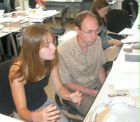For Kat Lexa '05, Heather Michael '07 and Meghan Dunn (George Washington '06), examining nearly 36,000 different molecular structures has proven both difficult and rewarding. The students are spending this summer in Hamilton's new Science Center studying the molecular composition of peptides in an effort to eventually produce a more effective drug for the treatment of breast cancer. With the assistance of Winslow Professor of Chemistry George Shields, Lexa, Michael and Dunn have been studying alphafetoprotein (AFP), a naturally occurring protein made up of eight amino acids known to inhibit breast cancer. By using computer software to examine various combinations of 10 to 15 different molecules, they are able to study what it is that makes this protein effective in fighting cancer.
Lexa, a chemistry and public policy double-major from Healdsburg, California, said that the study of cancer has been a longtime interest of hers. "Since I was brought up in sunny California, I've known a lot of people who have been affected by skin cancer, and the actual mechanism of the disease has fascinated me since my high school Biology class," she said. She worked on the project two summers ago and now intends to make it the focus of her senior thesis project. Ultimately, she said, her goal is to produce a drug modeled on AFP. "Proteins aren't stable enough to be used as drugs themselves," she said.
Shields expanded upon this explanation of why proteins, which are comprised of amino acids, are not good drugs: "Our bodies are designed to break them down. Every time we eat meat, the body clears out the amino acids with enzymes." He said it will be approximately six more months before the findings of this project will be ready for publication. He was quick, however, to temper his words with caution, citing the uncertainty of science: "Sometimes you think you've got it until you run one more test and realize that you've got to start all over again."
| Summer Research 2004 |
The project began five years ago with the work of Assistant Professor of Biology Stephen Festin. Under the supervision of Tom Anderson at Albany Medical College, Festin had begun work geared toward isolating what AFP targets within the body and what it binds to in order to shut down the development of cancer. Shields said he thought it would be a good complement to the work of Anderson's group to study AFP itself, in order to create a "mirror-image of the peptide side," allowing for a better model of the low-energy bond formed between AFP and its receptor. The first student to work on the project was Sam Bono '00, who made it his senior thesis. Other students who have contributed to the project include Jennifer Derby '01, Lorena Hernandez '03 and Damien Ellens '03.
Shields said that he likes students to work "as independently as possible," preferring to allow them to figure things out for themselves and come to him when they need assistance. He described summer research as being an "apprenticeship," saying that he is able to use it as a time to teach each of his students "how to be a scientist." He said he wrote a grant proposal for this project, but that most of his work with the students has been talking them through the problems they encounter.
 Heather Michael '07 |
Michael, who is from Red Hook, New York and is currently undecided on a major, said she has come to enjoy the way summer researchers are forced to work more independently. "As one of 15 students conducting research in coordination with Professor Shields, I haven't been able run to him with every small obstacle that I have encountered," she said. "Instead, I have been forced to struggle through the many day-to-day dilemmas, and in doing so, I have learned the value of self-sufficiency. Yet, throughout all, Professor Shields serves as a faithful and patient consultant—always offering encouragement and insight."
Lexa and Michael's research is funded by Merck. Dunn receives her funding from the National Science Foundation.
